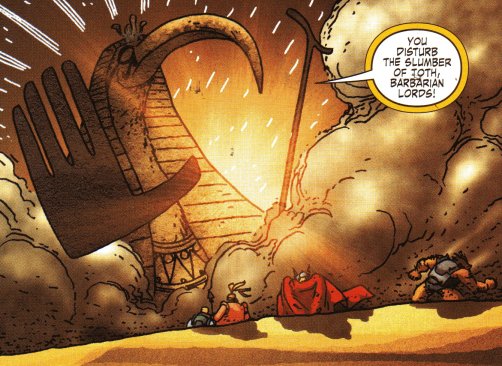 THOTH
THOTH THOTH
THOTH
Real Name: Thoth
Identity/Class: Extradimensional (Heliopolis) god
Distant Past, Pre-Cataclysmic era, Hyborian era, Post-Hyborian era through calender Birth of Christ era; World War II (covering from 1930-1945) and modern era
Occupation: God of
Wisdom;
former ruler of Heliopolis;
former God of the Moon
Group Membership: Ennead (Heliopolitan gods of Egypt); formerly the Ogdoad (Hermopolitan gods of Egypt)
Affiliations:
Hellbent,
Karanthes,
Keftu, Knights Templar,
Rammon,
Rammon
(son of Rammon);
formerly worshipped by the Egyptians,
and the Nemedians of the Hyborian era
Enemies: Azoth, Jaggta-Noga, Set, Thoth-Amon, unidentified Black Ring sorcerer
Known Relatives: Nun
(Demiurge, father),
Neith
(Gaea,
mother),
Ammon
Ra
(Atum, brother), Seshat (wife), Panther God (Bast,
nephew),
Bes
(nephew),
Lion
God (Sekhmet,
nephew), Shu (nephew), Khonshu
(Chons,
nephew), Hathor, Tefnut (nieces), Mahes (Apedemak, grandnephew), Geb
&
Nut
(grandnephew
and grandniece),
Osiris,
Seth
(great-grandnephews),
Isis,
Nepthys (great-grandnieces),
Anubis,
Horus
(great-great-grand-nephews),
three unidentified sons (may just be creations);
if the Elder Gods are to be considered
siblings, then
Chthon, Hyppus, Oshtur, and Set are his
uncles and aunt.
Aliases: A, A'an, Asten, Djehuty, God-Bird of Shadow-Haunted Stygia, Hab, Ibis, Ibis the Invincible, Judge of the Two Combatant Gods, Khenti, Lord of Divine Words, Lord of Khemennu, Lord of Ma'at, Mehi, Sheps, Toth
Base of Operations: Temple of Thoth (presumably
associated with the realm Celestial Heliopolis);
previously Hermopolis;
Born in
Khemennu
(near modern-day El Ashmunein, Egypt);
his worshippers had multiple Temples of
Ibis, including in Numalia, Nemedia and in Akkhora, Shem; the
Nest of Sacred Ibis, a few hours
horseback ride from Messantia, Argos, was the primary seat of worship
after the Ibis worshippers were driven from Stygia
Education: Extensively self-educated
First Appearance:
(Referenced) Captain America Comics#20 (November, 1942);
(seen; as Ibis) Marvel Feature I#6
(September, 1976);
(seen; as Thoth) Thor: Blood Oath#6
(February, 2006)
Powers/Abilities:
Thoth presumably has the standard godly abilities, such as superhuman
strength, durability, etc., as well as extreme longevity (he is at
least 12,000 years , if not a million years, old or older), resistance
to conventional disease, etc. He is known for his extreme wisdom. At
least in the past he had certain abilities related to the moon.
As Ibis, 10, 000 BC and before (perhaps
for hundreds of thousands, or even a million years or more), it would
appear that Thoth engaged in some direct combat with beings as powerful
as Set, though it may be that he only opposed Set's actions and never
actually fought the Elder God. He granted power to such items as the
Eye
of Ibis and the Staff
of Ibis.
He may have supplied power to the Book of Toth, though that may have
been a black magic tome that used his name in vain.
Thoth typically adopts an ibis-headed
form when appearing before humans.
Height: 6'4" (variable)
Weight: 280 lbs. (variable)
Eyes: Black
Hair: None
History:
(Official Handbook of the
Marvel Universe Deluxe Edition#5: Heliopolis / Official Handbook of the
Marvel Universe A to Z hardcover#4: Gaea - BTS) - At some point after
the birth of Atum, Gaea (known as Neith to her children in this family)
again mated with the Demiurge (known as Nun) to parent another son,
Thoth.
(Official Handbook of the Marvel Universe A to Z hardcover#6: Khonshu / Official Handbook of the Marvel Universe: A-Z Update#3: Demogorge - BTS / myth history) - Atum, in the guise of Ammon Ra, apparently spawned the Ogdoad, gods of Egypt dwelling in Hermopolis. Thoth served with the Ogdoad as the god of wisdom and the moon.
(Marvel Zombies: The Book of Angels, Demons, and Various Monstrosities: Set - BTS) - Thoth was also known as Ibis in the distant past.
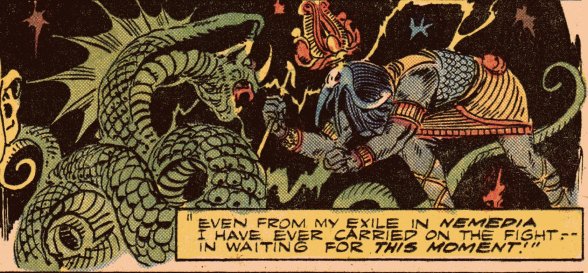 (Conan the Barbarian I#7 (fb) - BTS) - Ibis and
Set were foes "since Earth's first dawn."
(Conan the Barbarian I#7 (fb) - BTS) - Ibis and
Set were foes "since Earth's first dawn."
(Marvel Feature I#6 (fb) - BTS) - Ibis and Set fought in the outer darkness for a thousand centuries.
(Conan: The Horn of Azoth (fb) - possibly (see comments)) - In the distant past, before man first crawled from the slime, Azoth was a god on Earth. In battle with another god, Azoth's horn was torn from his brow by another god. Azoth's body died, petrifying and forming what would become known as Azoth's peak, in what would become Zamora in the Hyborian era.
(Conan: The Horn of Azoth (fb) - BTS) - As the age of man began, the legend of Azoth was passed down amongst worshippers of the god Ibis. As they could not destroy the Horn of Azoth, they instead imprisoned it within the Crypt of Shadows, which could only be opened with their religious icon, the Eye of Ibis.
(Conan: The Horn of Azoth (fb)) - Azoth's worshippers, in preparation for a certain day of celestial alignment, stock-piled thousands of corpses and created a literal river of blood, which flowed into the center of Azoth's peak, sustaining the demon for a thousand thousand years.
(Marvel Feature I#7 (fb) - BTS) - Upon the death of each of the High Priests of Ibis, his remains were interred within stone sarcophagi. When six such sarcophagi were filled, a new policy was enacted. As each new High Priest died, the bones of the longest interred were moved into the much larger "Chamber of Skulls."
(Marc Spector: Moon Knight#59 (fb)
- BTS / Official Handbook of the Marvel Universe A-Z#5) - Thoth made a
pact with the Knights Templar (or their predecessors), granting them
secrets of wisdom, creation, and death in exchange for the Knights'
promise to protect the hidden race of human/elder race hybrids known as
the Hellbent.
Recognizing these secrets as too
powerful for frequent use, the Knights hid them away, and they became
the core of the Arcane Archives, accessed via Hellhole (a subterranean
base located miles beneath a temple in the Brazilian Amazon).
(Marc Spector: Moon Knight#50 (fb)
- BTS) - The Templars tracked and protected one particular family
lineage whose descendents shared a unique genotype (gene-trait) unknown
to the majority of them, the house of the collective subconscious of
all their ancestors. If catalyzed through a method known only to a few
in the Templars, this genotype allowed generational heirs to become the
ultimate personification of the Bloodline, with full access to the
combined knowledge and singular specialties of their entire family
tree. This knowledge included the ability to access the Arcane Archives.
The genotype was catalyzed by expression
of a certain gland in the neck, followed by the Bloodline's recitation
of a certain phrase, "Praeterit est parens ad futurum," which means
"The past is parent to the future."
(Savage Sword of Conan - discussion of Gods of the Hyborian era, whatever issue that was) - In the Hyborian era, Ibis was prominently worshipped in parts of Nemedia and Stygia.
(Conan the Barbarian I#68 - BTS) - Ibis was said to live in the bodies of the herons by Stygia's River Styx.
(Conan the Barbarian I#115 (fb) - BTS) <centuries before the days of Conan> - A Temple of Ibis was established in Akkharia, one of the southernmost states of Shem.
(Marvel Feature I#6 (fb) - BTS / Marvel Feature I#7 (fb) - BTS) - Despite Ibis' backing, Thoth-Amon and other followers of Set drove Karanthes and the other priests of Ibis from Stygia.
(Marvel Feature I#7 (fb) - BTS) - Karanthes and the other priests of Ibis moved the sarcophagi and the Chamber of Skulls of their past High Priests with them.
(Space Science Fiction: God in the Bowl / Conan the Barbarian I#7 - BTS) - The Stygian sorcerer Thoth-Amon sent the Man-Serpent Sschaaronn to slay Karanthes, a priest of Ibis. Conan slew Sschaaronn before he ever reached Karanthes.
(Marvel Feature I#7 (fb) - BTS) - While the priests of Ibis were exiled to Nemedia, a minor priest named Keftu died. As his foremost desire and final request was to guard the Chamber of Skulls even after his death. His skeleton was placed within the Chamber, axe in hand, and enchantments provided to reanimate him if any attempted to disturb the sacred bones.
(Marvel Feature I#7 (fb) - BTS) - Karanthes and the other priests of Ibis eventually relocated their sarcophagi and the Chamber of Skulls to a new, southernmost Temple of Ibis, the Nest of the Sacred Ibis, a few hours ride from Messantia (a sea port of Argos).
(Marvel Feature I#7 - BTS) - Conan and Red Sonja upset the bones in the Chamber of Skulls, and trashed much of the Temple of Ibis during a battle over a page from the Book of Skelos, which Sonja had obtained for Karanthes. An immense serpent emerged from where Keftu had lain, but Conan and Sonja slew it.
(Conan the Barbarian I#68 - BTS)
- After a Set-worshipping sorcerer of the Black Ring in the form of a
flying lizard creature stole the page from the Book of Skelos,
Karanthes made an offering to Ibis, asking him to give unto him that
which would need to recover the page. At the ritual's conclusion,
Karanthes had obtained the Fire-Jewel, a blood red gem the size of an
egg, which he gave to Conan to take with him as he pursued the monster.
Karanthes apparently cast a spell to
slow the monster's flight, or to speed Conan and Sonja's journey, which
then spread to Bêlit when she joined them.
The Black Ring sorcerer had used the
page to summon forth Valusia's City of Wonders from 8500 years before
and, posing as Kull's sorcerer-ally Gonar, had advised Kull to conquer
Argos to rebuild his kingdom. Conan gave the Fire-Jewel to Kull, which
exposed the Stygian sorcerer, and he eventually slew the sorcerer, but
the Skelos page burned to ashes as he died. Kull and his city returned
to their own time, while Karanthes failed to convince Conan, Sonja,
& Bêlit to aid him in claiming the whole Book of Skelos from
Kheshatta (the City of Magicians), Stygia, where Thoth-Amon held it.
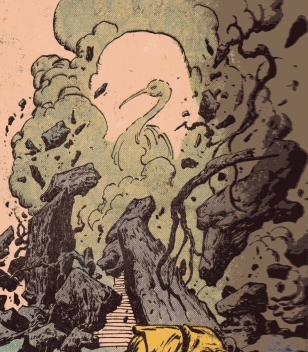 (Conan the Barbarian I#115) - Via Karanthes'
Ibis-staff, Karanthes dispatched Zukala's demon Jaggta-Noga back to his
nether realm. Ibis' image appeared as Karanthes cast the spell that
destroyed Zukala's citadel.
(Conan the Barbarian I#115) - Via Karanthes'
Ibis-staff, Karanthes dispatched Zukala's demon Jaggta-Noga back to his
nether realm. Ibis' image appeared as Karanthes cast the spell that
destroyed Zukala's citadel.
(Conan: The Horn of Azoth) - As the day of alignment approached, another Karanthes, this one a high priest of Azoth, sent his daughter, Natari, to recruit Conan to obtain the needed magical items. Under her direction, Conan snuck into the Temple of Ibis and stole the Eye of Ibis. Using the Eye of Ibis, Natari retrieved the Horn of Azoth from the Crypt of Shadows. Natari eventually brought the Horn back to Karanthes in Shadizar. Karanthes used the Horn to revive Azoth, but Conan tore the horn off anew, and Azoth crumbled.
(Official Handbook of the Marvel Universe A to Z hardcover#6: Khonshu - BTS) - After the Ennead succeeded the Ogdoad, Thoth surrendered the role of moon god to Khonshu, serving only as god of wisdom to the Ennead.
(Official Handbook of the Marvel Universe Deluxe Edition#5: Heliopolis - BTS) - Though much older, Thoth acted much like a contemporary of Osiris, his great-grandnephew.
(Official Handbook of the Marvel Universe Deluxe Edition#5: Heliopolis - BTS) - Thoth served as vizier to Osiris when he took over the rule of the Ennead.
(Official Handbook of the Marvel Universe Deluxe Edition#5: Heliopolis - BTS) <30 BC> - After Osiris, Isis, and Horus were imprisoned in the Pyramid of Kings by Seth, Thoth was left to rule the Ennead. In the past, previous generations of ruling Ennead had departed Earth upon retiring from their rule and traveled to Celestial Heliopolis to live out eternity. Upon taking over leadership, noting the diminishing influence of the Ennead, Thoth relocated all the remaining Ennead from Earth to Heliopolis, to traffic with Earth no more.
(Thor I#241 - BTS) - Thoth was apparently unable or unwilling to stop Seth from torturing Geb and Nut just outside the city of Heliopolis.
(Captain America Comics#20/1) - Led by the spawn of the Witch-Queen who wore animal masks depicting various Egyptian Deities, the Egyptian Cult of Black Magic sought to resurrect their Witch-Queen, using the Book of Thoth and human sacrifice in order to conquer the world. They were foiled by Captain America.
(Thor: Blood Oath#1 - BTS) - As part of an agreement to make amends for the Warriors Three killing his son, Holth, the Storm Giant Gnives sent Thor and the Warriors Three on a series of missions, with the final task being entrance into the Temple of Toth, guarded by his three warrior sons, whose sole purpose is to keep the tombs silent.
(Thor: Blood Oath#6) - Thor
transported himself and the Warriors Three to the Temple of Thoth (Toth
in this story), guarded by the three immense statue-like, snake-headed
sons of Thoth. When Thor announced their intention to seek the Hill of
Toth, one of the sons raised a finger, and the Asgardians were pulled
beneath the sands by large tentacles. Upon their escape, Fandral leapt
into the air and sliced off of the warrior's right hand, while Thor
hurled the spear Slaughter (weapon of Cuchulain), which shattered one
of the sons of Thoth. Volstagg stopped another son from
stomping on Hogun, and Hogun made his way to the Hill of Toth. Plagued
by scorpions, Hogun nonetheless cried Odin and Thor's names, which
caused the remaining sons of Thoth the scream and shatter.
When Gnives dispatched the troll Ulik to
try to prevent the Asgardians from accomplishing their final goal, the
struggle disturbed the sleep of the ibis-headed Thoth, who appeared and
sent them all back to their own realm, instructing them to return no
more or there would be war in the Heavens.
(Official Handbook of the Marvel Universe Deluxe Edition#5: Heliopolis - BTS) - In the modern era, Thoth returned the throne to Osiris after his liberation from the Pyramid of Kings and the defeat of Seth.
(Marc Spector: Moon Knight#59 - BTS) - Seth the Immortal, Moon Knight, several Hellbent, Templar Chloe Tran, and Jean-Paul DuChamp entered the Arcane Archives. Jean-Paul noted that this cavern alone hid 36, 535 lost scrolls of Thoth containing the Egyptian legends of creation. In the ensuing battle, Seth was bound in Adamantium and cast into the caverns, but the violence within the realm has activated fragile magma faults, and Hellhole was swiftly consumed by the lava and flames.
Comments:
Based on the paucity of appearances, it's hard to identify a real
writer.
Stan Lee referenced him first in Marvel
Comics. REH established the existence of Ibis as an enemy of Set, and
Roy Thomas adapted that work into the Marvel Universe. Roy Thomas and
Frank Thorne did the first story that pictured Ibis.
Michael Oeming and Scott Kolins showed
Thoth (or Toth) in his current identity.
This profile is not intended to cover the activities of every one of Ibis' and/or Thoth's followers. It is mostly intended for actions more directly involving Ibis/Thoth.
Thanks for Spidermay for expanding the Nest of Ibis sub-profile.
There is an appearance
(as an image---floating head ) of Thoth in Marvel Tales I#96 (6/1950)
reprinted in Crypt of Shadows#14 (11/1974) page 4 panel 1 (...the heads
of all the ancient deities of Egypt----Aset/Eset (Isis), Hor/Heru
(Horus), Het-Heru (Hathor) and Thoth/Djehuti/Zehuti/Tehuti). Also seen
is the Set (Seth/Sutekh) in flashback and his beautiful demoness the
Sphinx (the Great Sphinx is called Hu by the ancient Egyptians).
Thanks to "The Book of the Dead" by E.A. Wallis
Budge, Dover Publications, Inc., New York (1967) I have been able to
translate into ancient Egyptian the names of buildings and objects
mentioned and seen in the Thoth profile. Het Thoth or Per-Thoth (Temple
of Thoth), Mesu Thoth (Sons Of Thoth), Seset En Sespsi Tekh (Nest Of
Sacred Ibis), Het Tekh or Per-Tekh (Temple Of Ibis), Met En Tekh or
Khet En Tekh (Staff Of Ibis), Tekh-Khet or Tekh-Met (Ibis-Staff). Sat
En Thoth (Book Of Thoth) and Maat Tekh (Eye Of Ibis). Per-Satet (The
Temple Of Satet) is on page 191; Het Sai (Temple Of Sand) is on page
240; Sat (book) is on page 26; Seset (nest) is on page 95; Khet (staff)
is on page 102; Met (staff) is on page 116; Tekh (ibis) is on page
cxviii; Mesu (the sons of) is on page 3; Sepsi (sacred) is on page 230;
Maat Heru (Eye Of Horus) or Maat Ra (Eye Of Ra) is on page 47; and Khet
En Ankh (the staff of life) is on page 172 of "Gods of the Egyptians or
Studies in Egyptian Mythology Volume 2" by E.A. Wallis Budge (1969).
--Gammatotem
According to some notes on the internet (I forget the source, sorry)
Azoth
Profile by Snood.
CLARIFICATIONS:
No KNOWN connections to:
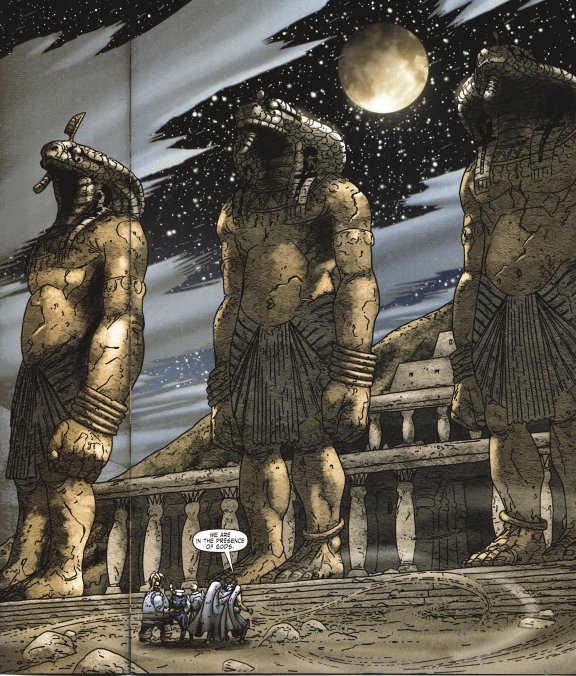 TEMPLE of THOTH / SONS
of THOTH
TEMPLE of THOTH / SONS
of THOTH
(called Temple
& Sons of Toth in Blood Oath)
It is unclear whether they are literal sons of Thoth, or just magical creations. They are immense, perhaps 50' tall, possessing great strength and durability. They are apparently composed of flesh covering stone/sand.
(Thor: Blood Oath#1 - BTS) - As part of an agreement to make amends for the Warriors Three killing his son, Holth, the Storm Giant Gnives sent Thor and the Warriors Three on a series of missions, with the final task being entrance into the Temple of Toth, guarded by his three warrior sons, whose sole purpose is to keep the tombs silent.
(Thor: Blood Oath#6) - Thor
transported himself and the Warriors Three to the Temple of Toth,
guarded by the three immense statue-like, snake-headed sons of Thoth.
When Thor announced their intention to seek the Hill of Toth, one of
the sons raised a finger, and the Asgardians were pulled beneath the
sands by large tentacles. Upon their escape, Fandral leapt into the air
and sliced off of the warrior's right hand, while Thor hurled the spear
Slaughter (weapon of Cuchulain), which shattered one of the sons of
Thoth. Volstagg stopped another son from stomping on Hogun,
and Hogun made his way to the Hill of Toth. Plagued by scorpions, Hogun
nonetheless cried Odin and Thor's names, which caused the remaining
sons of Thoth the scream and shatter.
When Gnives dispatched the troll Ulik to
try to prevent the Asgardians from accomplishing their final goal, the
struggle disturbed the sleep of the ibis-headed Thoth, who appeared and
sent them all back to their own realm, instructing them to return no
more or there would be war in the Heavens.
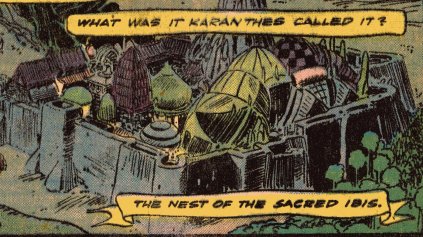 NEST of
SACRED IBIS / TEMPLE of IBIS
NEST of
SACRED IBIS / TEMPLE of IBIS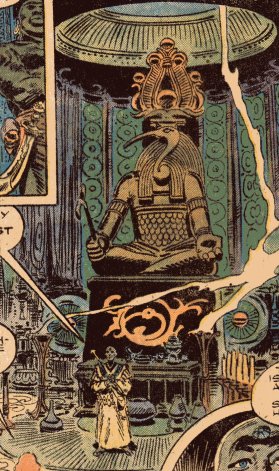
The Nest of Sacred Ibis was a village in Argos, a few hours ride from Messantia. The Temple of Ibis within it was the primary seat of the worshippers of Ibis, and it contained the sarcophagi and Chamber of Skulls of past High Priests of Ibis.
During the time of Karanthes and Red
Sonja, the Nest of Ibis was a citadel, surrounded by high
walls, hosting a Temple of Ibis along with many of
his priests and
worshippers. The walls surrounded several high builidings. Its
inhabitants were, for the most part, Stygians.
The Temple was open to visitors but was
guarded by two Kushite guards. It housed valuable vases, high
candlesticks
and walls of precious or colored stone. At the centre of the main hall
was
a statue of Ibis that stood taller than three men, and sat
on a plinth of dark
stone with an altar before it.
In the same hall sat six sarchophagi containing the remains of six high priests of Ibis. When a great priest died, the older bones among the six were taken into the Chamber of Skulls, leaving space for the body of the newly departed priest. The Room of Skulls contained the bones of hundreds of great priests, either of the cult of Ibis or the cult of Set, bones of an uncalculable age. The bones were taken to the Nest when the worshippers of Set banished the followers of Ibis and they gained a faithful guardian during their Nemedian exile. Keftu, a loyal follower and priest of the Cult of Ibis, was granted his last and greatest wish: after his death, he would stand guard at the Room of Skulls with his double-axe. And so his bones were placed there, but under them, a more deadly guardian stood, a giant, green snake that would strike if anybody dared to touch Keftu's bones.
The
Chamber of Skulls was turned
upside-down when Conan the Cimmerian and Red Sonja fought inside. They
scattered Keftu's bones and had to kill the python.
--Marvel Feature Presents#7 (Conan the Barbarian I#68, ?Conan the
Barbarian I#115
images:
(without ads)
Thor: Blood Oath#6, p6-7 (sons and temple of Toth)
Marvel Feature I#6, p6, panel 3 (vs. Set)
Conan the Barbarian I#115,
3rd from last page, panel 4 (Ibis' image over destruction of Zukala's
citadel)
Marvel Feature I#7, p7, panel 5 (Nest of the Sacred Ibis)
Appearances:
Captain America Comics#20
(November, 1942) - Stan Lee (apparent writer), Al Avison (artist)
Space Science Fiction: God in
the Bowl (September, 1952) - originally written by Robert E. Howard
(presumably 1932-1933), edited/revised by L. Sprague de Camp
Conan the Barbarian I#7 (July, 1971) - Roy Thomas (writer), Barry
Windsor-Smith (penciler), Sal Buscema & Dan Adkins (inkers),
Stan Lee (editor)
Marvel Feature I#6-7 (September-November, 1976) - Roy Thomas
(writer/editor), Frank Thorne (artist)
Conan the Barbarian I#68
(November, 1976) - Roy Thomas (writer/editor), John Buscema
(illustrator)
Conan the Barbarian I#115 (October, 1980) - Roy Thomas (writer/editor),
John Buscema (penciler), Ernie Chan (inker)
Thor: Blood Oath#1 (November, 2005) - Michael Avon Oeming (writer),
Scott Kolins (art), Molly Lazer, Andy Schmidt, & Aubrey
Sitterson (assistant editors), Tom Brevoort (editor)
Thor: Blood Oath#6 (February, 2006) -
Michael Avon Oeming (writer), Scott Kolins (artist), Molly Lazer, Andy
Schmidt, Aubrey Sitterson (assistant editors), Tom Brevoort (editor)
First Posted: 01/25/2009
Last updated: 01/22/2009
Any Additions/Corrections? please let me know.
Non-Marvel Copyright info
All other characters mentioned or pictured are ™
and
© 1941-2099 Marvel Characters, Inc. All Rights Reserved. If
you
like this stuff, you should check out the real thing!
Please visit The Marvel Official Site at: http://www.marvel.com
Special Thanks to www.g-mart.com for hosting the Appendix, Master List, etc.!